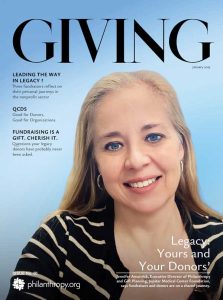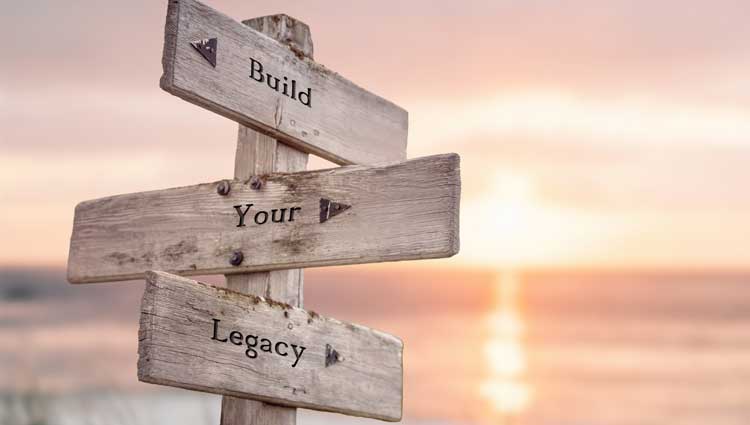
Jennifer Amarnick
Executive Director of Philanthropy and Gift Planning
Jupiter Medical Center Foundation
Jupiter, FL

When you imagine a fundraiser’s legacy, what do you picture?
When I think about a fundraiser’s legacy, I see it as a shared journey with a community. The first part is the impact on the donor, where we come together to match their philanthropic interest with the vision of the organization. The second part is the impact on the organization, where we work collectively to leave it better than we found it. The third part is the impact on our colleagues, where we support each other in advancing our careers and being good mentors.
What are your goals for your own legacy as a fundraiser?
Interesting question. At the core of my personal legacy, I want to be recognized for doing the right thing. I hope that when I end my career, I’ve positively impacted on my colleagues, the organizations I have been a part of, and the industry as a whole.
How are you building that legacy?
Building a legacy takes time. Currently, I spend time volunteering for industry organizations, such as the Planned Giving Council of Palm Beach County, where I serve as President and have the privilege of serving as a committee member for the education tracks of the NACGP Conference. I believe that volunteering is not just a way to give back, but also a powerful tool to inspire and motivate others. I have been fortunate to have had others do that for me. From an organizational standpoint, I try to incorporate best practices in everything we do. This mindset goes back to “doing the next right thing.” Regarding donors, I have been able to support donors who have given $25 memorials to 8-figure gifts. In each of those interactions, I strive to provide the donor with the most impactful experience. These gifts may be all that person has to give, and I hope they know that their gift is impactful when our conversation is completed.
What (or who) has contributed most towards building your legacy?
There are so many people. Fundraising was part of a career switch, so there were people before I even became a fundraiser who helped shape how I approach building my legacy. The foundation has to start with my family. They are the why behind all that I do. But if I had to look at two individuals in the fundraising industry who helped me along the path, I would say the first is Anthony J. Robinson, who is now with the American Red Cross. He took a chance on me and hired me at the American Cancer Society when I was changing careers, and he has continued to be a mentor and friend for the past 17 years. He was the first person to tell me that the knowledge and skills I had from my previous career could and would transfer beautifully. He also reminds me, “To whom much is given, much is expected.” That simple phrase has helped me in many ways as I have grown in my career. The other person would be Bobby Collier, the Senior Vice President of Planned Giving at the American Cancer Society. In a fortuitous meeting, Bobby opened my eyes to the opportunities to grow my skills in planned giving. The essential words Bobby shared with me early in my transition to planned giving were, “I can teach you anything you know to know, but I can’t teach who you are.” These words have been influential in the way I look at hiring new team members as well as mentoring other fundraising professionals. Bobby continues to be an essential part of my development as a fundraising professional and a leader.
How does creating a legacy for donors help shape a fundraiser’s legacy? Or are they separate?
They are very much intertwined. My legacy as a professional doesn’t exist if I am not working with philanthropic-minded individuals. With that being said, I do not believe the size of the donor’s legacy influences my legacy as a professional. In many cases, the most impactful gifts are the ones that come genuinely from a selfless place and yet may only be a relatively small gift. These gifts, though modest in size, carry a powerful message-they remind us that you don’t have to have the most significant gift to make an impact. They empower us and fill us with hope for a more inclusive and impactful philanthropic sector.
What led you to a career in fundraising?
Like many, I needed to follow a more complex path. I left a career in and around the golf industry when I became a mom. I remember seeing a position with the American Cancer Society that was grass-roots, events-focused. I lost my father to cancer when I was in college, and I felt this was a way I could give back in some form for the support this organization provided to so many. I told my husband I wanted to do this for a year or two, and then I would return to the sports world—a desire for change that many of us can relate to. As you can see, those 2 years have now turned into 17 years.
What keeps you in this career?
Inspiration. The personal inspiration I draw from this work is what keeps me going. Having worked at a leading national organization and now at a medical center, I can see the immediate effect of the donor’s gifts on patients, families, and the community. It’s truly inspiring to hear about a gift you worked with a donor on and how it changed a program, an organization, or a person’s experience. It’s a career that I am deeply connected to and motivated by.
What moments in your career would you include in your legacy story?
If given the opportunity, I would include them all. All of the successes and all of the failures. I believe it’s crucial to share both sides of the philanthropic journey, as it fosters a sense of connection and understanding. I would include a Relay for Life event that I worked on in a community that was not known to be philanthropic. Not because they didn’t want to but because of economics and societal biases. That event was probably one of the most rewarding experiences of my entire career. It wasn’t the most money ever raised, but it was memorable for the community. I would include a story of a donor who had given minimally to the medical center, but our team was there to support him. When he passed, he left an impactful gift through his estate, which will benefit Jupiter Medical Center. I would include being involved with the Planned Giving Council of Palm Beach County and the Palm Beach County Estate Planning Council. Both of those organizations and their members have been instrumental in my development as a professional, and I hope I have been a part of their growth as well. Probably the most impactful moment for me so far was showing my children the impact philanthropy had on the community when I showed them the advancements at the medical center. In real-time, I was able to look at my legacy through my children’s eyes, and that moment was special.
What role have your donors played?
The donors have always been the most important part of the journey. None of the above happens if I’m not working with donors. There are no events or advancements without the donors and the community. The donors are not just a part of my journey, they are the driving force behind my professional growth, and I am committed to using that growth to help them fulfill their philanthropic goals.
What would you recommend to fellow fundraisers looking to build a legacy of their own?
I recommend finding great mentors to help you along the way. I currently have a team of mentors. Some are in the fundraising world, others are not, and they play a vital role in developing my legacy. These mentors have been instrumental in my personal growth and I encourage everyone to seek similar guidance. My other recommendation is to be patient with yourself, especially if you are in the early phases of your career. Take the time to learn and build a solid foundation to pass your knowledge and experiences to the next group of fundraisers that come after you.